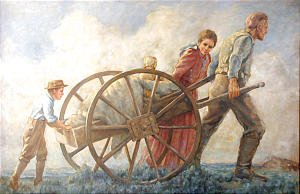Designed
to haul less than 100 pounds, more than 250 flimsy two-wheeled handcarts that
could
be pushed or pulled were made locally for European Mormons headed west from
Iowa City in 1856.
Many perished. Sketch courtesy University of Northern Iowa archives.
|
By Bob Hibbs
A
1,400-mile journey on foot from Iowa City to Salt Lake marks a unique American
tragedy resulting from what an early local history calls “deluded people”
without frontier skills setting out into the wilderness too late in the season
to offer hope of success.
The
Mecca at Salt Lake for converts to the Mormon Church of Jesus Christ of Latter
Day Saints brought some 1,300 European immigrants, chiefly from England and
Wales, to the Iowa City train depot during April, May and June 1856.
The
tracks had been built into Iowa City only months before, making the local
Mississippi & Missouri Railroad depot the western terminus from the east
coast.
The
church had provided covered wagons earlier, but its financing plan failed,
making handcarts necessary to haul meager supplies. Ten to 15 miles daily
meant the walk would take 110 days or more.
A
decade earlier, Brigham Young and followers had abandoned Nauvoo, Illinois,
just across the river from Ft. Madison, and founded a Mormon Valhalla in a
desert on the shores of Great Salt Lake. Their route became the Mormon Trail.
Mormon
immigrants made camp along the Clear Creek in a scattered pattern from what
now is southern Coralville to near Tiffin. The Iowa City street name of Mormon
Trek Boulevard recalls their camp. Neglected graves left behind provide mute
testimony to reality.
Their
chief piece of equipment, one for every five people, consisted of two wooden
wheels with thin strips of iron as tires connected by a wooden axel which
supported a box to hold clothing, bedding and food, limited to 17 pounds per
person.
The
rickety conveyance was fragile at best and life-threatening at worst.
They
huddled in tents and a few in covered wagons, with their meager supplies of
food cooked over open fires. Area residents provided assistance, particularly
the Iowa City Masonic Lodge since Mormon leaders were Masons.
Believers
looking west toward their promised land ignored hardships waiting along the
trail – from flooded rivers and unfriendly Native Americans to snow in
mountain passes of the Rockies.
Vast
stretches of unsettled country offered no supplies anywhere. “Let them come
on foot, with handcarts or wheelbarrows, and nothing shall hinder or stay
them,” the church had declared as a “Devine Plan.”
They
left Iowa City in five groups, the first with 226 on June 9, exactly 148 years
ago last Wednesday; a second started two days later and a third largely Welsh
on June 23. Another departed in mid July, the other July 28.
The
first group lost three children before reaching Council Bluffs, just 250 miles
into the trek. Settlers in Iowa often fed hungry travelers; while the country
beyond the Missouri River was unsettled – no roads, no bridges, no wells, no
repair shops, no groceries, no inns, no settlements.
Iron
tires wore out, axels broke, and precious bacon had to be used for axel
grease, reducing already inadequate foodstuffs.
Men
often ate the daily allowance of 10 ounces of flour at breakfast, then pushed
a handcart all day, going to bed hungry. A little rice, sugar, coffee and
bacon were occasional luxuries; but deer and buffalo roaming the prairies were
unavailable since the travelers lacked hunting skills.
The
smaller early groups reached Salt Lake with moderate losses. Winter caught the
last two; a rescue party eventually brought in remnants of a tragic exercise
in pain, suffering and death brought on by unbounded faith.
An
1883 history of Johnson County refers to the “Mormon emigration” as
“deluded people,” recording that three young women were helped “to
escape,” with one returning to England, while the others married and
remained in Iowa.
The
Mormon trek west from Iowa City is a tale of senseless tragedy. Copyright 2004
By Bob Hibbs
Bob
Hibbs collects local postcards and other historic ephemera and researches
history related to them.
Return to Handcart History Index |
